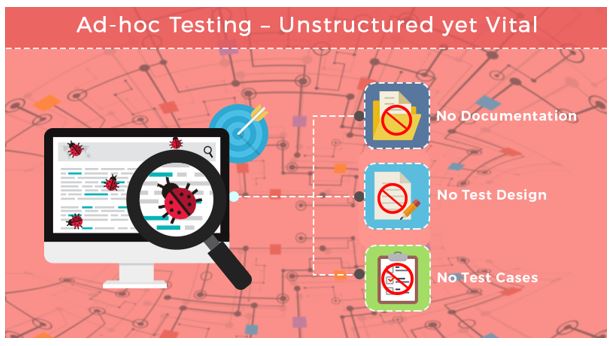Automated Software Testing Services are a big ocean in itself. With numerous techniques and multi-faceted tools to support, the testing framework and environment are all dependent on certain pre-defined steps, methodologies, and structures, based on which the processes are performed. It is a very well-observed fact that at certain times if you tend to do testing with a lot of pre-definition and perfection, there are chances of missing out on the random reactions or unplanned actions, which are equally important when it comes to the actual performance of the project. That is where Ad-hoc testing plays an important role. It is a highly effective technique for system testing barring any advanced planning of test cases or test documentation. With no limitations and no documentation, this is a freestyle of testing done by testers with their own creative tints and perception to extract the unseen flaws in the software. In the arena of Software Test Automation, the main objective behind Ad-hoc testing is to discover defects or errors that cannot be caught through traditional or recognized processes followed during the testing cycle.

When is the Apt Time to Perform Ad-hoc Software Testing?
- Limited Time to Perform
There are situations when the testers face a highly restricted time to test owing to different circumstances like budget, timelines, infrastructure, etc. At such times, Ad-hoc testing comes to the rescue by offering the creative knowledge of randomly checking the software. With a popular technique called ‘Error Guessing’, this style involves a testing group that is experienced enough to guess in advance, what possibly could be the flaws in the system, by observing the pre-requisites needed.
- Lack of Testing Documentation
In Software Quality Assuring Services, where there is a lack of testing documentation like test cases, test plans, etc., Ad-hoc testing is the only way out. There is no need of any planning, process or documentation wherein no defect is mapped to any test case and hence the tester is free to cull out as many bugs as possible.
- Highly Complex Requirements
There are certain projects in which there are a lot of complex scenarios with a variety of requirements, implementation complexities, geographical challenges etc. In such cases, when we follow only pre-determined steps and testing procedures, humanly, there are chances of neglecting or over-looking certain conditions which will crop up only when they are randomly tested. These defects will surface in situations with no documented steps.
Key Advantages of Ad-hoc Testing
- It is a simplistically implemented testing style since there is no process involved. Without any planning or documentation, it gives full authority to the tester to find the faults and increase code coverage benefits. It can also be done anytime during the entire project cycle – be it the start of the project, during the coding phase, or prior to implementation.
- It does save a lot of time, which usually is spent after designing and documenting testing steps. No doubt, these documents have their own significance, but in certain situations, it is not possible to undergo that much writing owing to stringent schedules and deadlines. At such time, Ad-hoc testing comes as the right option.
- There is a marked increase in the testing quality and efficiency because of the increased freedom given to the tester to find out the defects. It makes a lot of difference since they are not bound by the typical traditional methods. They have the free hand to perform whichever way they want to, independently or clubbing it with other testing styles.
- One of the flexible advantages is that it can be executed anytime anywhere during the entire project execution cycle. There are no set rules about its execution-style and hence is very easy to implement.
Challenges Posed by Ad-hoc Testing
- At certain times, this type of testing comes in the way of structured project execution steps like user testing, acceptance etc. It is not feasible to undergo Ad-hoc testing while any kind of formal testing is already being executed or is under planning.
- Dependency solely on this may lead to missing out on most major functionalities. Since there is a lot of freedom involved, testers may get highly attracted to it and this may indirectly tend to neglect certain important areas of the entire system.
- It is very tough to monitor and manage this kind of testing approach since there is no documentation involved. How to judge the portion completed, pending, in progress, etc. becomes a big question mark.
- For the tester to reproduce the errors is a tough task, since the errors that are encountered, are ad-hoc and not thought of. Hence, when it comes to showing the error to the development team, there are chances that the same error may not recur and hence leading to utter confusion.
With its pros and cons, this innovative style of testing does bring with it, the tester’s creativity and satisfaction, which surely gives out positive results. If used appropriately at the perfect time, it is sure to yield good results.
SPEC QA offers independent QA and Testing Services across the complete software release lifecycle. We guarantee a process-driven approach in all our quality assurance practices and software testing services.
Our Automated Software Testing Services make certain an accurate blend of Manual and Automated Testing and provide support through the Testing Life Cycle. As a Software Testing and Quality Assurance Company in India, we possess skilled resources in Automated Testing tools like Selendroid, Selenium, Appium, Robotium, Quick Time Pro, Load Runner, etc. which help in simulating scenarios and performing continuous routine mundane tests.
With a stringent focus on quality and processes, we have been implementing several testing projects in a multitude of technologies. Request a Free POC to test-drive our services.





